- Home
- Julian May
The Golden Torc
The Golden Torc Read online
Table of Contents
Title Page
Table of Contents
Copyright
Dedication
Epigraph
Synopsis of Volume I
PART I
1
2
3
4
5
6
7
8
9
10
11
12
13
PART II
1
2
3
4
5
6
7
8
9
10
11
12
13
14
15
16
PART III
1
2
3
4
5
6
7
8
9
10
11
12
Epilogue
Appendixes
Apologia Pro Geologia Sua
Map of Northwestern Europe During the Pliocene Epoch
Map of Western Mediterranean Region During the Pliocene Epoch
Map of Eastern Aven (Balearic Peninsula) During the Pliocene Epoch
Footnotes
Copyright © 1982 by Julian May
All rights reserved. No part of this work may be reproduced
or transmitted in any form or by any means, electronic or
mechanical, including photocopying and recording, or by
any information storage or retrieval system, except as
may be expressly permitted by the 1976 Copyright Act or in
writing from the publisher. Requests for permission should be
addressed in writing to Houghton Mifflin Company, 2 Park
Street, Boston, Massachusetts 02107.
Library of Congress Cataloging in Publication Data
May, Julian.
The golden torc.
(Saga of Pliocene exile; v. 2)
I. Title. II. Series: May, Julian. Saga of Plio-
cene exile; v. 2.
PS3563.A942G6 813'.54 81-4126
ISBN 0-395-31261-2 AACR2
Printed in the United States of America
V 10 9 8 7 6 5 4 3 2 1
For Barbara,
nurse and redactor and sternman
Open the door to us, and we will see the orchards,
We will drink their cold water where the moon
has left its trace.
The long road burns, hostile to strangers.
We wander without knowing and find no place...
Before us is the door; what use for us to wish?
Better to turn away, abandoning hope.
We will never enter. We are weary of seeing it.
The door, opening, let so much silence escape
That neither the orchards appeared nor any flower;
Only the immense space where emptiness and light are
Was suddenly everywhere present, overflowed the heart,
And washed our eyes almost blind under the dust.
"The Threshold," Simone Weil
translated by William Burford
Synopsis of Volume I
THE MANY-COLORED LAND
THE GREAT INTERVENTION of 2013 opened humanity's way to the stars, giving the people of Earth unlimited lebensraum, energy sufficiency, and membership in a benevolent civilization, the Galactic Milieu. Humanity became the sixth of the Coadunate Races, a commonwealth of planet colonizers who shared high technology and the capability of performing mental operations known as metafunctions. The latter—which include telepathy, psychokinesis, and many other powers—had lurked in the human gene pool from time immemorial, but only rarely were manifest.
By 2110, when the action of the first volume in this saga began, a kind of Golden Age prevailed. More than 700 fresh planets had been colonized by exuberant Earthlings. Humans with overt metapsychic powers were slowly increasing in number; however, in the majority of the population, the mind-powers were either meager to the point of nullity, or else latent—that is, nearly unusable, because of psychological barriers or other factors.
Even Golden Ages have their misfits, and the psychosocial structure of the Galactic Milieu had its share. A French physicist named Théo Guderian unwittingly provided these square pegs with a unique escape hatch when he discovered an apparently Useless phenomenon: a one-way, fixed-focus time-warp opening into France's Rhône River Valley as it existed during the Pliocene Epoch, six million years ago. Certain that a prehistoric Eden must exist on Pliocene Earth, an increasing number of misfits prevailed upon Guderian's widow, Angélique, to let them pass through the time-portal into "Exile."
From her husband's death in 2041 until 2106, the rejuvenated Madame Guderian operated a peculiar establishment that the Galactic authorities reluctantly tolerated. Her French inn, l'Auberge du Por-tail, served as a front for transporting clients from Old Earth to a world six million years younger. After suffering qualms of conscience about the fate of the transportées, Madame herself ultimately passed through the one-way gate into Pliocene Exile. Operation of the time-warp was taken over by the Galactic Milieu, which had found it to be a convenient glory hole for dissidents.
On 25 August 2110, eight persons, making up that week's "Group Green," were transported to the Pliocene: Richard Voorhees, a grounded starship captain; Felice Landry, a disturbed young athlete whose violent temperament and latent mind-powers had made her an outcast; Claude Majewski, a 133-year-old paleontologist recently bereaved of his wife and colleague; Sister Amerie Roccaro, a physician and burnt-out priest who longed to become a hermit; Bryan Grenfell, an anthropologist in search of his lover, Mercy Lamballe, who had preceded him through the gate two months before; Elizabeth Orme, a Grand Master metapsychic operator deprived of her stupendous mental powers by a brain trauma; Stein Oleson, a misfit planet-crust driller, who dreamt of leading a Viking's life in a simpler world; and Aiken Drum, an engaging young crook who, like Felice, possessed latent metapsychic powers.
These eight people successfully made the jump six million years into Earth's past—only to discover, as other time-travelers had before them, that Pliocene Europe was under the control of a group of maverick humanoids from another galaxy. The exotics were also exiled, driven from their home because of their barbarous battle-religion.
The dominant exotic faction, the Tanu, were tall and handsome. In spite of a thousand-year sojourn, there were still less than 20, 000 of them on Earth because their reproduction was inhibited by solar radiation. Since their plasm was compatible with that of humanity, they had for nearly seventy years utilized the time-travelers in breeding, holding Pliocene humanity in benevolent serfdom.
Antagonistic to the Tanu and outnumbering them by at least four to one were their ancient foes, the Firvulag. These exotics were mostly of short stature and reproduced quite well on Earth. Tanu and Firvulag actually constitute a dimorphic race—the tall ones metapsychically latent, the short ones possessed of limited operant metafunctions. The Tanu wear mind-amplifiers, collars called golden torcs, to bring their powers up to operancy. Firvulag do not require torcs, and most of them are weaker in mental power than the Tanu.
For most of the thousand years that Tanu and Firvulag resided on Pliocene Earth (which they called the Many-Colored Land), they were fairly evenly matched in the ritual wars fought as part of their battle-religion. The greater finesse and more sophisticated technology of the Tanu tended to counterbalance the superior numbers of the cruder Firvulag. But the advent of time-traveling humanity tipped the scales in favor of the tall exotics. Not only did Tanu-
human hybrids turn out to have unusual physical and mental strength, but humans also enhanced the rather decadent science establishment of the Tanu by injecting the expertise of the Galactic Milieu. The seventy years of time-traveling had seen nearly 100, 000 humans transported to Pliocene Europe; their assimilation gave the Tanu almost complete ascendency over the Firvulag foe (who never mated with humanity and generally despised them).
The lot of humankind under the Tanu overlords is by no means grim; people who cooperate are treated very well. All rough work is done by ramapithecines, small apes who wear simple torcs that compel obedience. (Ironically, these "ramas" are part of the direct hominid line that climaxed in Homo sapiens six million years later.) Humans occupying positions of trust or engaged in vital occupations under the Tanu usually wear gray torcs. These do not amplify the mind, but do allow telepathic communication between humans and exotics; the devices also incorporate pleasure-pain circuits, through which the Tanu reward or punish their minions. The torcs are not easily made, requiring a rare barium component in their manufacture, and so they are not used on the majority of "normal" (that is, meta-psychically nonlatent) humans, who are coerced into obedience by other means. If Tanu testing shows that an arriving time-traveler has significant latent metafunctions, the lucky person is given a silver torc. This is a genuine amplifier similar to the gold collars worn by the Tanu—but with control circuits. Silver-torc humans enjoy a privileged position; rarely, they may even be granted golden torcs and full freedom as citizens of the Many-Colored Land.
The eight members of Group Green, like all new arrivals, were taken for mind-testing to a Tanu fortress, Castle Gateway. Almost at once, the Group proved to be anything but typical. The starship captain, Richard, temporarily escaped and had a terrifying encounter with a Tanu slave-mistress, Epone, who administered the tests for latent metafunctions.
Elizabeth, the former farsensor and metapsychic teacher, discovered that passage through the time-warp had triggered restoration of the awesome mental powers she feared had been lost forever. Her discovery was noted with excitement by another Tanu, Creyn, who promised Elizabeth that a "wonderful life" lay ahead of her in the Many-Colored Land.
Stein Oleson, the huge driller, was driven temporarily insane by the trip back through time. Smashing the door of his detention cell, he was subdued only after killing a number of gray-torc bondsmen. To insure Stein's future docility, he was fitted with a gray torc of his own. His heroic physique made him a candidate for the Tanu-Firvulag ritual war, the Grand Combat. Still unconscious from his recapture, he was readied for a trip south to the Tanu capital city of Muriah.
Also torced—but with silver—was the trickster youth, Aiken Drum. The exotic testers had detected strong metapsychic latencies in him, which would be brought up to the operant level as he became accustomed to wearing the amplifier.
The anthropologist, Bryan Grenfell, possessed no significant mental latencies. But his professional talents seemed strangely valuable to the Tanu, with the result that Bryan was able to bargain his cooperation in return for Tanu help in finding Mercy—and a torcless status.
The old bone digger, Claude Majewski, showed no hidden mind-powers. With some disdain, minions of the Tanu informed him that he would be sent north to the city of Finiah, together with most of the week's bag of time-travelers, and put to work. He found himself incarcerated in Castle Gateway's "people pen," together with more than thirty other ordinary humans, awaiting the departure of the northern caravan. In the prison dormitory lay Richard, comatose from mental abuse by Epone.
The last members of Group Green to be tested by the exotic slave-mistress were Sister Amerie and Felice Landry. The nun had no important latencies. Faced with being tested next, Felice seemed seized by hysterical fear; her agitation made an accurate calibration impossible. Epone gave up on the girl, since she could be tested later in Finiah. Then, in an offhanded way, Epone informed the two of the Tanu custom of using human women for brood stock, dismissing their indignant protests with the promise that they would eventually accept the role and even be happy with their new life in Finiah. When the exotic woman left them, Felice's feigned hysteria vanished. She had succeeded in concealing her strong latent metafunctions from Epone, escaping the torc at least temporarily; and now she resolved in cold fury to "take" the entire Tanu race.
That evening, two caravans left Castle Gateway, traveling along the Pliocene River Rhône in opposite directions. In the northern group, bound for Finiah on the Proto-Rhine at the edge of the Black Forest, were the partially recovered Richard, Claude, Amerie, Felice, and the majority of the other human prisoners. They were escorted by Epone and a squad of gray-torc human troops. In the southern cavalcade, led by Creyn, were Elizabeth, Bryan, Aiken Drum, the wounded Stein, and two other silver-torc humans: a former juvenile officer from a colonial satellite, Sukey Davies, and a glum Finno-Canadian forester, Raimo Hakkinen.
At first the northern train made peaceful progress. Suffering from having to ride a huge Pliocene mount called a chaliko, Amerie searched her soul and began to understand the neurotic pressures that had led her to abandon her ministry. Richard, recuperating with the help of Claude, stewed in helpless rage when his position became clear. He was dubious, but subconsciously receptive, when Felice proposed a scheme for escape.
Two days out of Castle Gateway, Felice's plan was activated. She had three weapons: preternatural strength in a deceptively slight body, the ability to mind-control animals (an aspect of her metapsychic latency she had used during her athletic career), and a small knife that had escaped detection. Felice broke the chains holding her Group Green friends and those of four other prisoners. Then Richard, disguised in Amerie's religious robes, was able to stab the officer of the guard to death. Meanwhile, Felice mentally coerced the caravan's ferocious bear-dog escort, forcing the animals to attack the other soldiers and Epone. A wild fracas ensued, in which the freed prisoners, together with the mind-controlled bear-dogs, killed not only the rest of the soldiers, but the Tanu Epone as well.
In the moment of triumph, Felice sought to take Epone's golden torc, knowing it would release the latent metafunctions heretofore imprisoned within her brain. But a half-crazed time-traveler threw the device into a lake, where it sank in deep water. Felice was prevented from murdering the interfering man only when Amerie administered a powerful sedative from her medical kit, causing the little athlete to fall unconscious.
Bewildered and frightened, the ex-prisoners realized that telepathic news of the attack must have been flashed by the dying Epone. Most of the escapees elected to follow a mountain-climbing Oxford don, Basil Wimborne, who proposed to lead them in small boats across the prehistoric Lac de Bresse to safety in the high Jura. Claude, wilderness-wise from expeditions on wild planets of the Galactic Milieu, demurred. He advised taking to the forests of the adjacent Vosges Mountains, where it would be difficult for gray-torcs on chalikoback to pursue them. Only Richard and Amerie agreed to follow him, taking the still-unconscious Felice along.
From a high ridge, the four members of Group Green saw gray-torc boats in pursuit of their former companions. That evening, Amerie felt herself strangely attracted by Felice's violent behavior, which seemed to reflect some dark shadow within her own conventional spirituality.
While crossing a torrent on the following day, Amerie fell and broke her arm. The others made camp and tried to decide what to do. Felice seemed to take for granted that they would all lead a guerilla existence, harassing other caravans in the hope of getting another golden torc. Richard received this notion with scorn. The only sensible thing was to make for the sea, away from the regions that the Tanu were known to inhabit. Claude, knowing that Richard was right, but troubled at leaving the impetuous girl behind on her own, went off into the quiet woods to think. After burying his late wife's ashes, he fell asleep, waking at evening to find that a tiny Pliocene cat with illusions of domesticity insisted upon accompanying him back to camp. The cat, Claude felt, would be a valuable dis
traction for Amerie, who was becoming morbidly preoccupied with Felice.
Man and pet returned to camp to find that all trace of the others had vanished. Fearfully, Claude went up the riverside path. The time-travelers had been warned of the terrible Firvulag who inhabited the Vosges forest. Now it seemed that Richard, Felice, and Amerie must have been abducted by the shape-shifting little exotics—or else recaptured by minions of the Tanu. Hearing voices, then compelled against his will to reveal himself, Claude came upon the very desperados who had seized his friends. They were not exotics but human beings— free humans who had escaped from exotic bondage and now lived an outlaw life.
Their leader was a well-rejuvenated old woman wearing a golden torc: the widow of the time-gate's discoverer and the ultimate author of Pliocene humanity's degradation ... Angélique Guderian.
On the last day of August, the four members of Group Green, Madame Guderian and her band, and some 200 other "Lowlives" (as the free humans proudly styled themselves) came to a hiding place in a giant hollow tree deep in the Vosges Mountains. The forest now swarmed with Tanu and their gray-torc henchmen, sent by Lord Velteyn of Finiah to search out the killers of his sister, Epone. Velteyn himself, proficient in the metafaculties of psychokinesis and creativity, was conducting personal sorties at the head of his Flying Hunt, a cadre of glorious Tanu knights in glass armor, made levitant by their lord's mental power.
Safe in their sanctuary, the Lowlives and Group Green engaged in mutual assessment. Madame told the newcomers of her grandiose plan to free all of Pliocene humanity from Tanu bondage, a task she had undertaken in expiation of her own guilt. She had engineered a fragile alliance between Lowlives and Firvulag against the common Tanu enemy; but the entente had been only minimally productive.
The Tanu were oddly invulnerable to the vitredur glass and bronze weapons commonly used by all three races. Tanu might suffer injury, but after a recuperative course administered by redactors—metapsychic healers—even the worst wounds would be cured. Madame and her chief fighter, a Native American named Peopeo Moxmox Burke who had once been a judge, were keenly interested in how Group Green had managed to dispatch Epone. Until this time, no Lowlife had ever been able to kill a Tanu. Felice displayed her little steel knife, and a fact that Amerie had already suspected became confirmed: Iron was poisonous to the Tanu, perhaps acting in some way to destroy the linkage between the exotic brain and the golden torc. (Felice looked upon Madame's own golden torc with some speculation at this point, but the intrepid old woman simply pricked herself with the blade to show that humans were made of tougher stuff.)

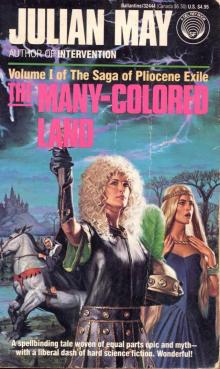 The Many-Coloured Land
The Many-Coloured Land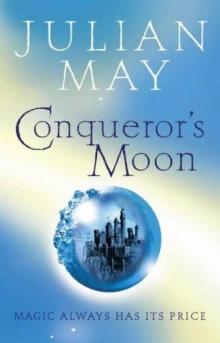 Conqueror's Moon
Conqueror's Moon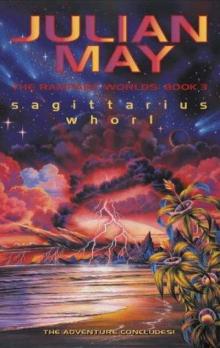 The Sagittarius Whorl
The Sagittarius Whorl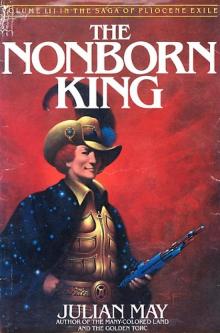 The Nonborn King
The Nonborn King Sky Trillium
Sky Trillium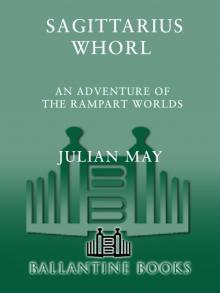 The Sagittarius Whorl: Book Three of the Rampart Worlds Trilogy
The Sagittarius Whorl: Book Three of the Rampart Worlds Trilogy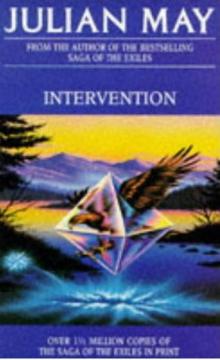 Intervention
Intervention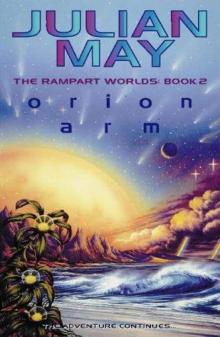 Orion Arm
Orion Arm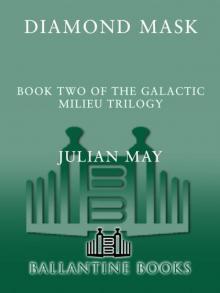 Diamond Mask
Diamond Mask The Golden Torc
The Golden Torc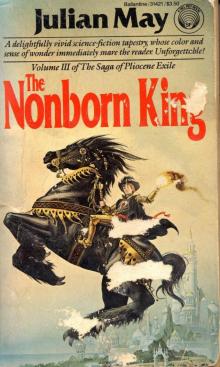 The Noborn King
The Noborn King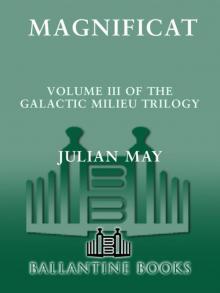 Magnificat
Magnificat Jack the Bodiless
Jack the Bodiless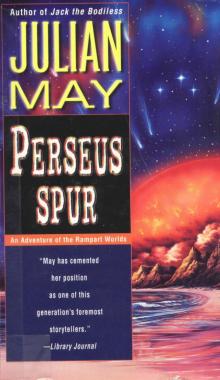 Perseus Spur
Perseus Spur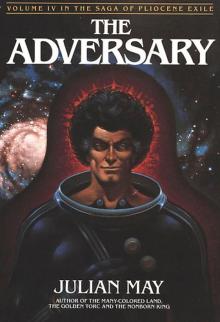 The Adversary
The Adversary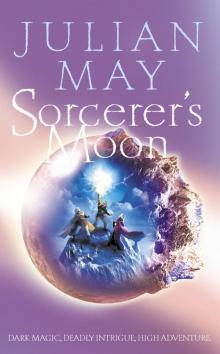 Sorcerer's Moon
Sorcerer's Moon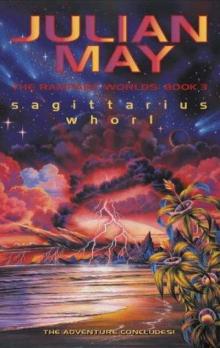 Sagittarius Whorl
Sagittarius Whorl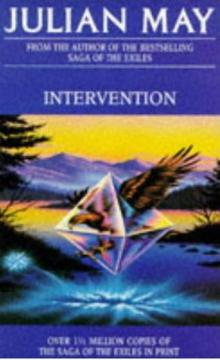 The Intervention (Omnibus)
The Intervention (Omnibus)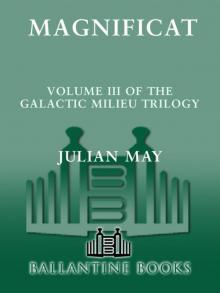 Magnificat (Galactic Milieu Trilogy)
Magnificat (Galactic Milieu Trilogy)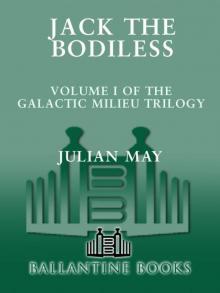 Jack the Bodiless (Galactic Milieu Trilogy)
Jack the Bodiless (Galactic Milieu Trilogy)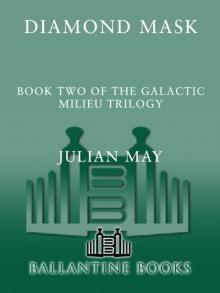 Diamond Mask (Galactic Milieu Trilogy)
Diamond Mask (Galactic Milieu Trilogy) The Many-Coloured Land sope-1
The Many-Coloured Land sope-1